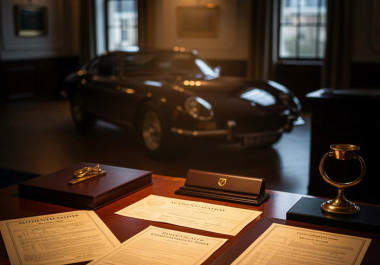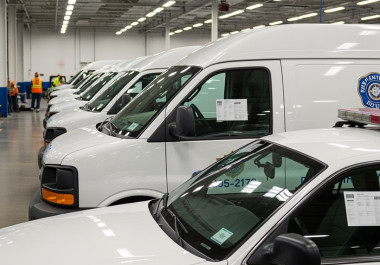Step into any car auction hall and you’ll notice the buzz. Engines rev, bidders shuffle nervously, and cars glide past under bright lights. In all that excitement, it’s easy to get carried away and overbid on something shiny. But here’s a piece of hard-won wisdom: before the hammer falls, the smartest buyers have already studied the pre sale estimate.
A pre sale estimate is more than just a number. It’s a professional valuation of what a vehicle is likely to fetch when it goes under the hammer. Think of it as your financial compass, a tool that points you in the right direction and helps you steer clear of costly mistakes. Without it, you’re sailing blind. With it, you can set a budget, plan a strategy, and bid with confidence.
In this guide, I’ll walk you through exactly what a pre sale estimate is, why it matters, and how you can use it to your advantage. I’ll also share a few auction-floor stories from my years in the motor trade, where the right estimate made all the difference between grabbing a bargain and dodging a money pit.
Understanding the Pre-Sale Estimate
At its simplest, a pre sale estimate is a professional opinion of what a vehicle is worth before the auction begins. It’s based on:
-
The car’s condition, both cosmetic and mechanical.
-
Mileage and service history.
-
Market trends, including seasonal demand.
-
Comparable sales at recent auctions.
It’s not an exact science, no valuation ever is, but it’s a carefully considered prediction. In most cases, the estimate gives you a reliable target range for bidding.
A car auction estimate works in much the same way, but with a sharper focus on auction-specific dynamics. It factors in how similar vehicles have performed in the auction environment, which can differ from retail or trade valuations.
Here’s an analogy: buying a house often involves a surveyor’s report. You wouldn’t commit hundreds of thousands of pounds without first checking the walls, roof, and wiring. In the same way, a pre sale estimate gives you the confidence to bid on a car without worrying you’ve missed something vital.
Why Pre-Sale Estimates Matter in Car Auctions
A pre sale estimate plays several vital roles in the auction process.
Informed Bidding
When you know the estimated value, you’re less likely to overextend yourself. If the car’s pre sale estimate sits around £5,000, and the bidding rockets toward £8,000, you’ve got a solid reason to step back.
Risk Mitigation
Auctions can be risky places. A pre sale estimate helps you avoid overpaying for vehicles that look tempting on the surface but hide problems underneath. It’s a safety net for your wallet.
Negotiation Leverage
Sometimes the bidding goes higher than expected. With a pre sale estimate in hand, you’re better positioned to re-evaluate. If a seller is open to negotiation after the auction, that estimate gives you a fact-based anchor point.
Boosting Confidence
Above all, having a pre sale estimate is like having a trusted mechanic whispering in your ear. It cuts through the noise, keeps your focus sharp, and makes you feel more in control when the auction floor is buzzing.
How to Use a Pre-Sale Estimate to Your Advantage
Understanding what a pre sale estimate is only half the battle. The real value lies in how you apply it during your auction strategy.
Research and Preparation
Before any auction, do your homework:
-
Gather Data: Collect estimates for similar vehicles. Look at multiple sources to build a benchmark.
-
Compare Sources: Don’t rely on just one estimate. Cross-check car auction estimates from different professionals.
-
Review Vehicle History: A full service record, accident history, and MOT checks add context to any estimate.
This preparation turns a vague number into a powerful decision-making tool.
Setting a Realistic Budget
A pre sale estimate helps you set boundaries:
-
Determine Your Maximum Bid: Treat the estimate as your ceiling. If bidding climbs higher, resist the temptation to chase.
-
Account for Extras: Auction fees, transport costs, repairs, factor them all in.
-
Allow Flexibility: Market surprises happen. Keep a small margin for manoeuvre.
With this approach, your spending stays under control, and you avoid nasty financial shocks.
Reading the Auction Environment
Auction conditions often affect how much weight you give to a pre sale estimate.
-
Auction Format: Online auctions give you time to check numbers. In-person events are faster and more pressurised.
-
Competition: In a crowded room, bidders sometimes go way above estimates. That’s where discipline comes in.
-
Market Conditions: Seasonal demand or local economics can push prices up or down. Always factor these into your decisions.
Category-Specific Pre-Sale Estimates
Different types of vehicles require different valuation considerations. Inspectors and valuers know this, and so should buyers.
-
Cars: Pre sale estimates focus on mileage, service history, and accident repairs. Electronics play a big role too.
-
Vans: Heavy use is common. Estimates look closely at clutch wear, suspension, and load area condition.
-
Trucks: For HGVs, valuation hinges on engine health, braking systems, and frame integrity. One hidden issue here can cost tens of thousands.
-
Motorcycles: Estimates focus on crash repairs, tyre condition, and chain/brake wear.
-
Motorhomes: Beyond mechanicals, estimates also cover water systems, electrics, and interior fittings.
When browsing RAW2K’s wide listings, whether car auctions, van auctions, motorcycle auctions, or vehicle auctions in general, understanding how pre-sale estimates vary by category is key.
Regional Considerations for Pre-Sale Estimates
Valuations can also shift depending on where in the UK you’re buying.
-
Scotland: Harsh winters and salted roads mean inspectors watch closely for rust and corrosion.
-
Wales: Rural driving can leave suspensions worn, estimates often reflect this.
-
North West: Older stock is more common, so mileage and history weigh heavily in valuations.
-
South East: Vehicles may be newer, but high-traffic conditions mean clutches and brakes are scrutinised.
These regional nuances make RAW2K’s national coverage a huge advantage. No matter where you’re bidding, you get estimates grounded in local realities.
Common Misconceptions About Pre-Sale Estimates
Despite their usefulness, several myths still float around. Let’s clear them up.
Myth 1: A Pre Sale Estimate Is a Fixed Price
It’s not. It’s a guide, not a guarantee. Final hammer prices can swing higher or lower depending on demand.
Myth 2: Only Beginners Use Pre Sale Estimates
Not true. Even seasoned dealers rely on them. Why? Because they save time and sharpen strategy.
Myth 3: Once Given, an Estimate Doesn’t Change
Market conditions evolve, and so do valuations. An estimate is a snapshot in time, not a permanent figure.
Real-World Stories from the Auction Floor
I’ll never forget one fleet sale in Birmingham. A line of vans caught everyone’s eye , low mileage, decent bodywork, and attractive guide prices. The pre sale estimates suggested they’d go for around £6,000 each.
Sure enough, the bidding started steady. But as soon as two big players went head-to-head, the hammer fell at £7,500. I’d already decided my ceiling was the estimate plus £300. I stepped back. The winning bidder later had to swallow a hefty repair bill for clutch replacements across the fleet. My caution, grounded in the estimate, saved me thousands.
On the flip side, I once spotted a motorhome in Leeds with a modest pre sale estimate. The notes showed minor issues, worn upholstery and a leaky tap , but otherwise solid mechanics. Most bidders walked away. I trusted the estimate, bid within its range, and bagged it for less than half the cost of buying one retail. That motorhome served me for years.
These stories prove one point: pre sale estimates aren’t about predicting exact hammer prices. They’re about giving you the confidence to know when to bid and when to walk away.
Strategic Takeaways for Using Pre-Sale Estimates
To get the most from a pre sale estimate:
-
Do Your Homework: Combine estimates with your own research.
-
Stay Adaptable: Treat it as a guide, not a gospel.
-
Keep Learning: Compare estimates to real hammer prices. Over time, your instincts sharpen.
-
Leverage RAW2K’s Resources: From all cars to featured auctions, you’ll find plenty of opportunities supported by clear estimates.
-
Ask for Support: If in doubt, don’t hesitate to contact RAW2K for advice.
Why Pre-Sale Estimates Are Worth Using
Car auctions are thrilling. The speed, the competition, the chase for a bargain, it’s addictive. But excitement can cloud judgment. A pre sale estimate keeps you grounded.
It’s not a crystal ball. It won’t guarantee a win. But it does give you a benchmark, a strategy, and the confidence to bid smart. Whether you’re a private buyer chasing your first bargain or a business owner building a fleet, relying on pre sale estimates and car auction estimates turns chaos into clarity.
At RAW2K, every auction is backed by transparent valuations and a commitment to helping buyers make informed decisions. That’s what keeps professionals, dealers, and everyday buyers coming back again and again.
So next time you’re in the auction hall, or browsing online listings, remember this: when you’ve got a solid pre-sale estimate in hand, you’re not just another bidder. You’re a bidder with an edge.




